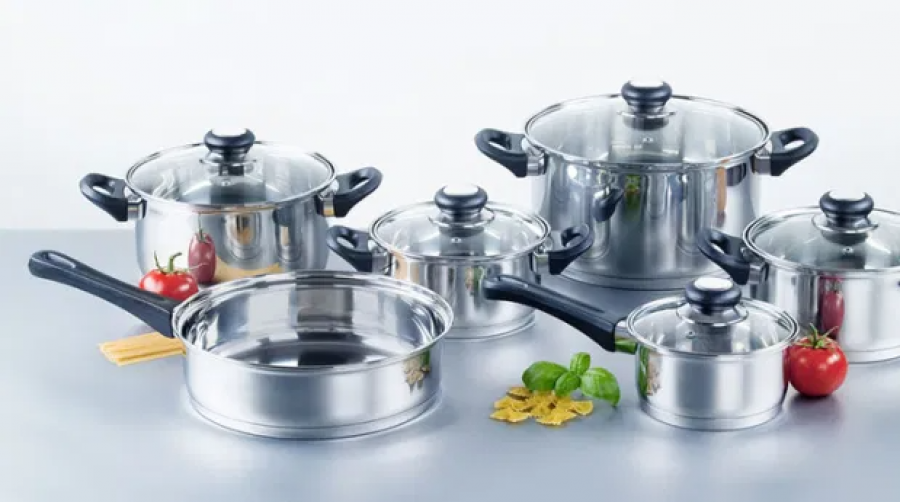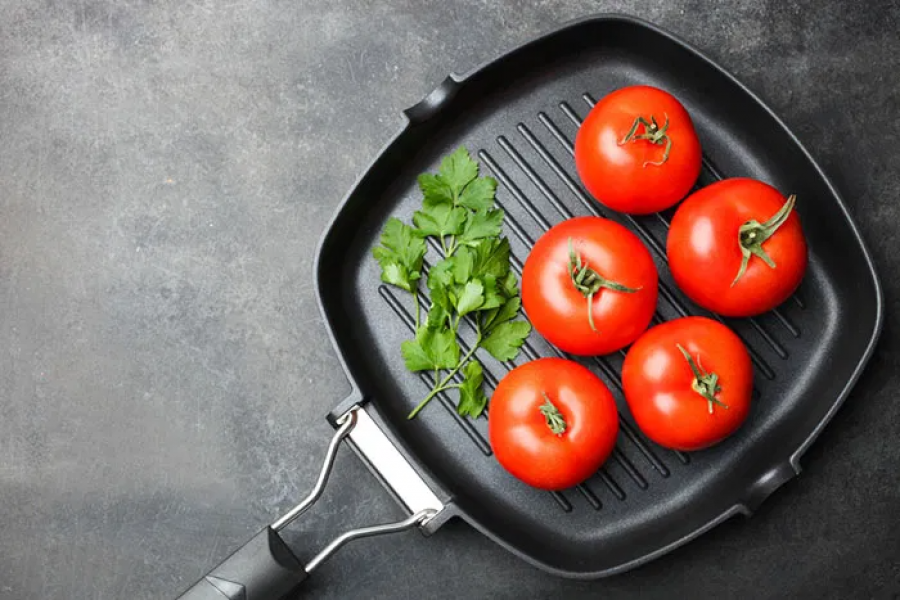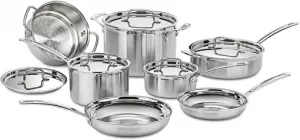Today, the nonstick feature is high in demand because it avails ease while cooking and saves money in terms of oil or butter. But is this functionality more important than your health, and the durability of the cookware? Here is a comparison of two distinct cookware materials; Stainless-steel and Nonstick, to help you understand which is better for you.
Stainless steel vs nonstick cookware: Let’s get started!
Stainless Steel vs Nonstick Cookware: Full Reviews
Stainless Steel Cookware Review

Stainless Steel is one of the least toxic cookware materials available. The best functionality it possesses is its durability and resistance to rust. Stainless steel is extremely robust and can withstand heavy-duty use without suffering any damage. This material is made from an amalgam of metals such as nickel, copper, carbon, iron, and, most importantly – at least 11% of chromium.
Despite the several layers of metals, only stainless steel comes in contact with the food – which does not release any toxic fumes. The process of the creation of stainless steel is a long one, and therefore, this material is relatively expensive. But it is worth the price because it is extremely durable, non-toxic, and sustainable.
Is Stainless Steel Cookware Safe?
Stainless steel offers one of the safest and healthiest ways of cooking your food. It is the least toxic cookware material, along with cast iron. Irrespective of the several metals in the layers of this material, the uppermost layer is stainless-steel, which does not release any toxic fumes.
After prolonged use, there’s a possibility of nickel or copper leaching into the food in fewer amounts. For some people, this is a major health hazard.
Advantages of Stainless Steel Cookware
Stainless steel is a robust and durable material. It is resistant to scratches, rusting, and does not dent easily. This material can withstand heavy-duty use.
This material does not release any toxic fumes into the food. Meals prepared with stainless steel are safe and healthy.
The weight of stainless-steel cookware is firm and perfect for maneuvering; it also does not give space for hot spots, allowing your food to be cooked evenly.
It can withstand high levels of temperatures; because of this food is prepared faster. You can make broth in it, sauté food, and much more.
Stainless steel offers compatibility with several cooktops, which lets you indulge in versatile cooking styles. It works with stovetops, grills, ovens, etc.
This material is very easy to clean, and it is dishwasher safe.
Disadvantages of Stainless Steel Cookware
This material is not a good conductor of heat – which does not allow the food to be cooked evenly. But because it can withstand high temperatures, it is cooked thoroughly.
Stainless Steel may have a smooth surface, but it is not nonstick. Due to this, food gets stuck to the surface, which is difficult to clean. You have to use metal scrubbers to remove the stubborn sticky layer.
MORE ABOUT STAINLESS STEEL COOKWARE:
Review of Cuisinart MCP-12N Multiclad Pro Stainless Steel Cookware Set
T-Fal Stainless Steel Cookware Review: Ratings & Brand Evaluation
Calphalon Stainless Steel Review: The Best Cookware?
Hard Anodized vs Stainless Steel Cookware – Which Is The Best?
Ceramic vs Stainless Steel – Which Cookware Fits Your Kitchen?
Cast Iron vs Stainless Steel Cookware: Which One Should You Choose?
Aluminum vs Stainless Steel Cookware – Which Cookware Material Is Better?
Nonstick Cookware Review

Nonstick cookware has been popularized because of the brand name TEFLON. Its main feature is, as the name suggests, a nonstick surface. Because of its smooth, non-porous surface, this material is extremely easy to clean and does not require a lot of greases to cook food. It is a relatively cheaper material, affordable and elegant in look.
This material is not durable, but it can last for enough years if you care for it properly. Nonstick is dishwasher safe and can be washed with hand only – sometimes just even warm water. The major drawback of this material is that TEFLON is a brand known to include PFTE and PFOA in its constituency; these are toxic elements which is harmful to your health.
Is Nonstick Cookware Safe?
Nonstick cookware has been through several controversies about the inclusion of PFTE and PFOA in its making. These elements are very toxic and not safe for consumption. When in contact with heat, nonstick cookware can release toxic fumes into the food. Moreover, vigorous cleaning of the surface can result in it chipping away.
But these days, TEFLON has gone through several improvements with due critique. The nonstick cookware today is PFOA and PFTE free, but there is still the risk of the surface chipping away and leaching into the food.
Advantages of Nonstick Cookware
Nonstick cookware material is extremely easy to clean. The smooth and non-porous surface can be hand-washed, with only warm water. It is dishwasher safe, as well.
This material requires very little greasing to cook food. Items like eggs do not require any type of oil or butter at all.
As the name suggests, nonstick cookware offers one of the best nonstick functionalities. This material is extremely efficient and doesn’t let any food stick to it.
It is a lightweight material – easy to store and easy to handle.
This material is easy to source, and make; therefore, it is relatively cheaper than most cookware materials.
Disadvantages of Nonstick Cookware
Nonstick is not durable. The uppermost layer can chip away with time, and the overall cookware does not last that long, either.
The material is known to have toxic elements such as PFTE or PFOA, which is extremely harmful to your health. Moreover, the uppermost layer can chip away and leach into the food.
Nonstick material cannot withstand high temperatures. It can release toxic fumes, and most importantly, melt the plastic. This can be harmful because of the food you consume, and also the air you intake.
MORE ABOUT NONSTICK COOKWARE:
All Clad HA1 vs B1 Nonstick Cookware – What’s the Difference?
Ceramic vs Nonstick Cookware: Which One Is Better?
Cast Iron vs Nonstick Cookware – Which One Shall You Choose?
Stainless Steel vs Nonstick Cookware: The Similarities and Differences

1. Compatibility and Versatility
Stainless Steel is an exceptionally versatile material. It is compatible with several cooktops, such as oven, grills, gas stoves, glass top stoves, and even induction cooktops if the alloy is magnetic. You can enjoy various styles of cooking with this material.
Nonstick cookware is not compatible with a lot of cooktops. It offers limited styles of cooking that you can indulge in. Nonstick cookware can be used with stovetops, and alloy can work with induction as well.
PS: It is clear that Stainless Steel offers much wider compatibility, and is extremely versatile.
2. Durability and Sustainability
Stainless Steel is immensely durable. It can withstand robust use; it is resistant to scratches and rusting; moreover, it does not dent easily. The stainless-steel material can last so long that it can even be passed down to generations. Because this material does not rust, the uppermost layer suffers little to no damage.
Nonstick cookware is relatively durable. But it does not last that long and can deteriorate with use. The uppermost layer of this material can chip away with vigorous scrubbing. That’s why it’s important not to grease the nonstick cookware a lot.
PS: Evidently, Stainless Steel shows great durability and sustainability.
3. Performance
Stainless steel is not a good conductor of heat. But, because of its ample weight, there are little to no hot spots on the surface of this cookware. Adding to this, because of the weight, it is easy to maneuver this cookware. It can withstand high temperatures of heat, allowing you to cook food fast and not waste any time to heat it.
Nonstick cookware can spread heat evenly, but they cannot withstand high levels of heat. It is also risky to keep the flames high as the material can release toxic fumes, or worse – melt.
PS: Performance is a very important aspect of cookware. Although nonstick is a good conductor of heat, it releases toxic fumes. Therefore, Stainless steel offers better performance.
4. Cleaning and Maintenance
Stainless steel has a smooth surface, which is easy to clean. This material is also dishwasher safe, making it easier for you to clean it. But you cannot hand wash it, as food gets stuck to the surface. Stainless steel is not nonstick, and the surface can get sticky – it can be removed with metal scrubbers.
Nonstick cookware is extremely easy to clean. You can simply hand wash it, even with just warm water. The smooth and non-porous surface does not need vigorous scrubbing. The scrubbing can ruin the uppermost layer of the cookware.
PS: I think that despite the repercussions, nonstick cookware material is much easier to clean.
5. Value for Money
Stainless steel is a durable, rust-resistant, scratch-resistant, and can withstand robust use. This material is compatible with several cooktops and allows you to cook versatile types of foods. It may be relatively expensive, but it is completely worth it because of all the beneficial features it possesses.
Nonstick cookware is easy to clean and offers great nonstick functionality. The surface is super smooth, which does not let any food stick to it. It distributes heat evenly but releases toxic fumes at higher temperatures.
PS: Nonstick material is cheaper than stainless steel, but for me, Stainless steel is worth it because it is feature-packed.
Which Cookware Material Is Better: Stainless Steel vs Nonstick?

At the end of this guide, I would like to declare Stainless Steel as the winner. It is a non-toxic material, extremely durable, and does not rust. This material is dishwasher safe and lasts long enough to be passed down to generations if maintained properly. Moreover, the ample weight of the cookware makes it easy to maneuver and avoid hot spots.
 Talya Davis
Talya Davis
Talya, like all members of the HomeDesignX team, is enamored by all things related to cooking and eating. She’s written cookware articles for numerous publications before working with her lifelong friend Jessica to create their very own website on cookware.
She's currently writing a book on induction cooktops, and enjoys making clean, vegan meals for her family.
